In Ireland, many homeowners installing solar PV panels wonder if they can sell or export surplus electricity back to the national grid, especially if they don’t have a smart meter. The short answer is: it is possible, but with important limitations and considerations.
1. Understanding Grid Export and Smart Meters
A smart meter is a digital electricity meter that can measure import and export electricity in real time, and communicate this data automatically to your electricity supplier. Smart meters make exporting energy easier and more precise for billing.
However, you do not strictly need a smart meter to export to the grid. Traditional export arrangements are possible, but they require additional hardware and manual arrangements.
2. How Export Works Without a Smart Meter
a) Feed-in Tariffs vs Net Metering
- Net Metering / Export Tariffs: Some energy suppliers in Ireland allow households to export excess PV electricity and receive payment. The compensation may be via netting off your bill or a small feed-in tariff.
- Without a smart meter, your exported energy is not automatically measured, so suppliers cannot calculate payments in real time.
b) Export Metering Options
To export without a smart meter, you need:
- Bi-directional export meter
- This meter can record electricity flowing back into the grid.
- It can be a standard mechanical or electronic meter installed by your energy supplier.
- Your supplier must approve the installation and connect it to your billing system.
- Manual Readings or Estimations
- In some cases, suppliers may estimate exported energy based on system size, orientation, and historical production.
- This method is less accurate and may lead to underpayment or overpayment.
c) PV Inverter Requirements
Your solar PV inverter must be grid-tie capable:
- Synchronizes output with grid voltage and frequency.
- Automatically stops exporting if grid voltage or frequency is out of limits (anti-islanding).
- Monitors total production (for your own records) and facilitates supplier export calculation.
Without a smart meter, your inverter cannot report export data directly to the supplier, so a separate export meter or manual submission is required.
3. Regulatory and Safety Considerations
a) Grid Code Compliance
All PV installations exporting electricity must comply with EirGrid/ESB Networks requirements:
- Connection agreements must be signed with your electricity supplier and ESB Networks.
- Inverters must meet European grid-tie standards (EN 50438 / IEC 61727).
- Anti-islanding protection is mandatory.
b) Licensing and Notification
- For small domestic PV systems (<11 kW), export is usually allowed without a separate license.
- You must notify ESB Networks before starting export.
- Your connection agreement will specify maximum export capacity, even if you don’t have a smart meter.
c) Safety for You and the Grid
- Exporting without proper metering does not remove safety responsibilities.
- Your system must be properly earthed and compliant with ET 101/ET 104 installation standards.
- Faults in export setup can create risks for line workers, neighbors, or your own equipment.
4. Practical Considerations
- Payment Accuracy: Without a smart meter, you may not be able to receive full payment for your exported energy.
- Future-Proofing: Many suppliers are moving to smart meter-based export tariffs, so non-smart setups may become obsolete.
- Monitoring: Even if you don’t have a smart meter, you should monitor production via your inverter’s app or display, so you know your PV system’s performance.
- System Size Limits: ESB Networks may limit the export from smaller PV systems without automated measurement to avoid grid instability.
5. Recommendations
- Contact Your Energy Supplier before installation to clarify export rules and available tariffs.
- Install an Export-Only Meter if you want accurate compensation without a smart meter.
- Ensure Your Inverter is Grid-Tie Compliant and meets Irish regulations.
- Keep Records of Energy Production, even if manual, for proof in billing or incentives.
- Consider Future-Proofing with a smart meter — as export tariffs evolve, smart meters will likely become standard.
✅ Key Takeaway
You can export solar PV energy to the grid without a smart meter in Ireland, but it comes with limitations on payment, accuracy, and future adaptability. For most households, installing a smart meter or export meter ensures precise billing, compliance, and a more seamless experience.
At Greenora.ie, we guide homeowners through PV system installation, export setup, and regulatory compliance to maximize returns safely. Contact us today to plan a solar PV system that works for your home and the Irish grid.
If you want, I can also draw a diagram showing how a domestic PV system exports to the grid with and without a smart meter, which would be excellent to include in the blog for clarity.
Do you want me to create that diagram?









